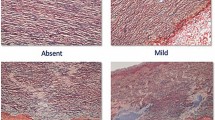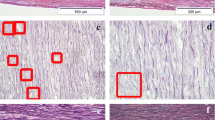Summary.
Patients with a bicuspid aortic valve tend to develop local enlargement in the convexity of the ascending aorta. There is controversial discussion as to whether this is a dilatation caused by abnormal hemodynamic stress or an aneurysm due to a common developmental defect of the aortic valve and the aortic media. Systematic studies of aortic wall specimens from patients with different diameters of the ascending aorta have not been available until now. We investigated histologically (HE, E.v.G., α-Actin, Alcian blue/van Gieson) aortic wall tissue obtained from 107 patients (31 female, 76 male, mean age 60.9±12.8 years) with a bicuspid aortic valve.
According to the preoperative measurement of the ascending aorta diameter, which was done by CT scan, angiography or echocardiography, the patients were divided into three groups [Group 1: ascending aorta diameter <3.8 cm; Group 2: diameter ≥3.8–4.9 cm and Group 3: diameter ≥5.0 cm].
We looked for histological signs of dilatation or more severe structural changes.
All patients of group 1 showed normal findings in histological examination. In 23 of 43 patients in group 2 (65.1%), we found histological signs of dilatation. Histological signs of dilatation were present in all patients in group 3.
We conclude that in patients with a bicuspid aortic valve histological signs of dilatation were more frequently found with increasing diameter of the ascending aorta.
More severe histological changes, such as cystic media necrosis, were not present.
Zusammenfassung.
Patienten mit bikuspider Aortenklappe entwickeln häufig eine lokale Ektasie im Bereich der Konvexität der Aorta ascendens. Es wird kontrovers diskutiert, ob es sich hierbei um eine Dilatation infolge der durch die malformierte Klappe bedingten, abnormalen hämodynamischen Belastung der Aortenwand oder ein Aneurysma aufgrund eines gemeinsamen Entwicklungsdefektes von Aortenklappe und Wand der Aorta ascendens handelt. Systematische Untersuchungen von Aortenwandpräparaten von Patienten mit bikuspider Aortenklappe und unterschiedlichem Durchmesser der Aorta ascendens fehlen bislang.
Wir führten histologische Untersuchungen (HE, E.v.G., α-Actin, Alcianblau/van Gieson) an Aortenwandgewebe von 107 Patienten (31 weiblich, 76 männlich, mittleres Alter 60.9±12.8 Jahre) mit bikuspider Aortenklappe durch.
Entsprechend des präoperativ mittels Computertomographie, Angiographie oder Echokardiographie gemessenen Durchmessers der Aorta ascendens wurden die Patienten in drei Gruppen eingeteilt [Gruppe 1: Aorta ascendens-Durchmesser <3,8 cm; Gruppe 2: Aorta ascendes-Durchmesser: ≥3,8–4,9 cm und Gruppe 3: Aorta ascendens-Durchmesser ≥5,0 cm].
Wir analysierten die Präparate nach dem Vorhandensein eines Normalbefundes, histologischen Zeichen einer Dilatation oder schweren strukturellen Veränderungen.
Alle Aortenwandpräparate von Gruppe 1 zeigten einen histologischen Normalbefund. Bei 28 von 43 Patienten von Gruppe 2 (65,1%) zeigten sich die histologischen Zeichen einer Dilatation. Die histologischen Zeichen einer Gefäßdilatation waren bei allen Aorta ascendens-Präparaten in Gruppe 3 zu beobachten.
Wir schlussfolgern, dass bei Patienten mit bikuspider Aortenklappe mit zunehmendem Durchmesser der Aorta ascendens häufiger die histologischen Zeichen einer Dilatation vorhanden sind. Schwerere strukturelle Veränderungen, insbesondere eine höhergradige zystische Medianekrose, sind nicht zu beobachten.
Similar content being viewed by others
Author information
Authors and Affiliations
Additional information
Eingegangen: 28. Februar 2002 Akzeptiert: 10. Juni 2002
Correspondence to Matthias Bauer
Rights and permissions
About this article
Cite this article
Bauer, M., Meyer, R., Bauer, U. et al. Verhältnis von Aortenwandveränderungen und Aortendurchmesser bei Patienten mit bikuspider Aortenklappe. Z Kardiol 91, 818–824 (2002). https://doi.org/10.1007/s00392-002-0847-6
Issue Date:
DOI: https://doi.org/10.1007/s00392-002-0847-6




